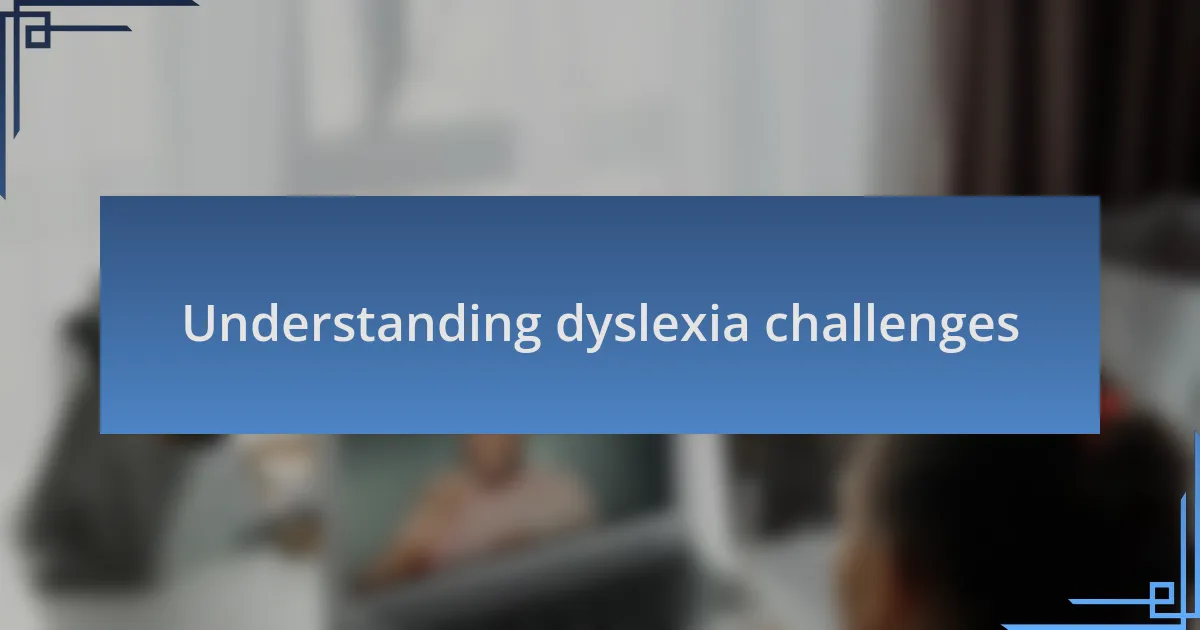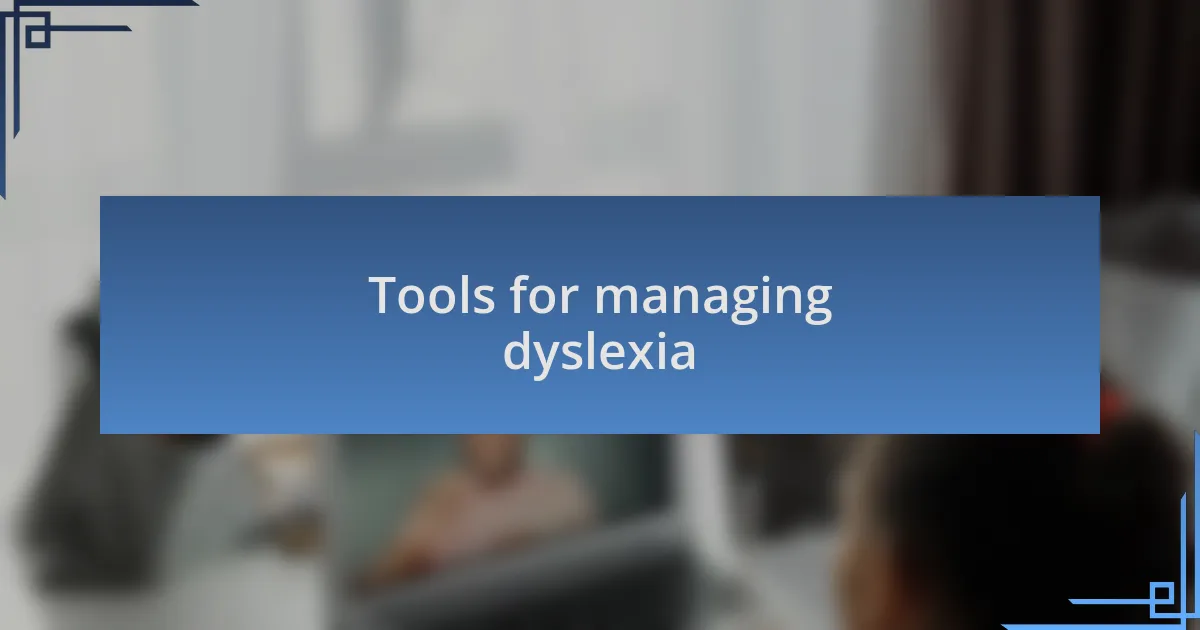Key takeaways:
- Dyslexia poses unique emotional and practical challenges, affecting self-perception and daily tasks.
- Dyslexia training helps individuals develop strategies, foster community, and change their mindset towards viewing dyslexia as a strength.
- Effective reading techniques, such as color overlays and breaking text into smaller sections, can significantly improve comprehension.
- Utilizing technology, structured routines, and organizational tools enhances productivity and aids in managing dyslexia’s effects.

Understanding dyslexia challenges
Understanding dyslexia challenges goes beyond just recognizing difficulties with reading and writing. For many, it can feel as though there’s a constant barrier to expressing thoughts clearly. I once felt overwhelmed in a classroom, surrounded by peers who seemed to grasp concepts effortlessly while I struggled with basic reading comprehension. This stark contrast can be not just frustrating, but emotionally draining.
The emotional toll dyslexia takes is often underestimated. I remember the fear and anxiety before presenting in class; the expectation to perform well felt like a weight on my shoulders. Have you ever felt that way? The truth is, it’s more common than you might think. Those feelings can linger long after the task is complete, shaping the way individuals view themselves and their abilities.
Moreover, navigating daily tasks like emails or social media can become a chore rather than a simple activity. I often found myself re-reading messages or getting stuck on certain words, which could cause embarrassment. How many times have you hesitated to hit ‘send’ on a text because you doubted your words? It’s a reality many face, and recognizing these challenges is the first step toward developing strategies to overcome them.

Importance of dyslexia training
Dyslexia training is vital because it provides the tools and strategies necessary for individuals to navigate their unique challenges effectively. I remember the first time I attended a workshop focused on dyslexia-friendly techniques. It was enlightening! I discovered ways to break down complex tasks into manageable steps, which felt like lifting a fog that had clouded my understanding for years.
Training also fosters a sense of community and belonging among those with similar experiences. Reflecting on my journey, I recall the warmth of connecting with others who shared my struggles—these conversations became a lifeline. Have you ever felt isolated in your challenges? It’s incredible how dyslexia training can help diminish that sense of loneliness, turning shared experiences into powerful discussions.
Ultimately, embracing dyslexia training empowers individuals to not only accept their learning differences but to celebrate them. I’ve learned to advocate for myself, whether it’s requesting accommodations or using assistive technology. It’s not just about developing skills; it’s about transforming one’s mindset from a place of limitation to one of potential. How would your life change if you saw dyslexia as a unique strength instead of a hurdle?

Techniques for effective reading
Reading can be a daunting task for those with dyslexia, but employing some effective techniques can truly make a difference. For instance, I often use color overlays on my text. This simple method reduces visual stress and helps me focus better on the words. Have you ever tried adjusting the background color when reading? It might surprise you how much it can enhance clarity.
Another strategy that has worked wonders for me is breaking up the reading material into smaller sections. When I tackle text in bite-sized pieces, it’s like lifting weights—each small success builds up my confidence and understanding. I still remember a time I struggled with a dense academic article, but by reading just a paragraph at a time, I could slowly piece together the content without feeling overwhelmed.
Lastly, it’s crucial to read aloud, especially when tackling challenging material. I discovered this technique during my training. Speaking the words provides an auditory experience that reinforces comprehension. Have you found that engaging multiple senses while reading helps you absorb information more effectively? I certainly have, and incorporating this simple habit turned my reading sessions from frustrating to fulfilling.

Tools for managing dyslexia
When it comes to managing the challenges of dyslexia, technology can be a game-changer. For example, I’ve found text-to-speech software to be incredibly helpful in my daily reading tasks. Listening to content being read aloud not only aids my comprehension but also reduces fatigue from decoding text. Have you ever considered how much easier it could be to follow along when you can hear the words?
Another tool that has made a significant impact in my life is the use of specialized reading apps. These often feature adjustable font sizes, backgrounds, and even formatting that caters to dyslexic readers. I remember being skeptical of these apps at first, thinking they wouldn’t make that much of a difference. However, once I gave them a try, the result was eye-opening; it felt like suddenly having a friend by my side, making reading less of a struggle.
Additionally, organizing my notes with digital mind maps has transformed how I process information. By visually laying out my thoughts and ideas, I can see connections that might not be as clear in traditional formats. I sometimes ask myself, how can a simple visual tool change the way I learn? The answer lies in the personal clarity it brings, allowing me to tackle complex subjects with confidence and ease.

Strategies for staying organized
Staying organized is crucial for anyone navigating dyslexia, and I’ve found that creating a structured routine works wonders. For instance, I set specific times each day dedicated to different tasks, whether it’s reading, writing, or reviewing notes. This consistency reassures me; it’s as if I’m giving my brain the exact cue it needs to switch gears effectively. Have you noticed how a little structure can make you feel more in control?
Another strategy that truly helps me is using color-coded calendars and planners. This system isn’t just pretty; it’s practical. Different colors represent various tasks or subjects, giving my eyes a quick reference that simplifies decision-making throughout my day. I recall feeling overwhelmed in the past, staring at an unmarked calendar. The colors have not only added clarity but also a bit of joy to my planning process—who knew organization could be so appealing?
Finally, I have adopted digital tools that work seamlessly across my devices. For example, using apps like Trello to create task lists helps me visualize my workload and check off completed items. I love how satisfying it feels to see those tasks disappear! It reminds me that, despite the challenges dyslexia presents, I can create a system that empowers me every single day. How do you keep track of what you need to do? Finding the right digital tool might just be the key to unlocking your productivity.

Personal experiences with dyslexia
Navigating daily life with dyslexia has shaped my viewpoint significantly. I remember the anxiety of opening a book in class, feeling the letters dance on the page, making comprehension feel just out of reach. Those moments taught me resilience; I learned that asking for help was okay and that everyone has their own unique struggles.
One vivid memory stands out when I first tackled written assignments. In high school, I often felt isolated, dealing with the frustration of spelling errors and grammar mistakes. However, I discovered that sharing my experiences with friends—a simple, honest conversation—helped to lessen that burden. I found that many were not only empathetic but eager to support me with study sessions and editing my work.
Now, I often reflect on how the experience of dyslexia has endowed me with creativity and problem-solving skills. For instance, when faced with a tricky reading assignment, I turned it into a game, breaking it down into manageable pieces. This approach didn’t just lighten the load; it transformed learning into an enjoyable challenge. Have you tried making your tasks a bit more playful? It can change your entire mindset toward what once felt daunting.

Tips for ongoing support
Finding ongoing support can be transformative. In my journey, I discovered that connecting with online communities made a significant difference. Engaging in forums where I could share my challenges and triumphs helped me feel less alone. Have you ever found comfort in a like-minded group? It’s incredible how much encouragement you can receive from others who truly understand your experience.
I also found that utilizing technology is a game changer. Tools like text-to-speech software have been invaluable for me. The first time I used one, it was as if a weight was lifted off my shoulders. Watching words come alive through audio made comprehension more accessible and enjoyable. Have you explored any specific apps or resources that support your learning? The right tools can enhance your journey significantly.
Lastly, establishing a routine is crucial. I realized that setting aside regular time for reading and writing helped me build confidence. Initially, I felt overwhelmed, but breaking my study sessions into short, focused intervals allowed me to make steady progress. Do you have a special routine that supports you? Finding a rhythm tailored to your needs can truly transform how you handle challenges.